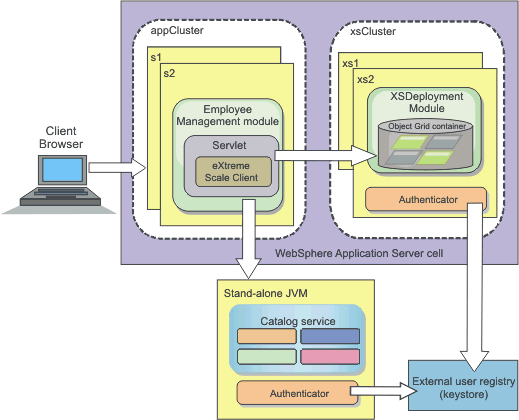Administration guide > Secure the deployment environment > Tutorial: Security in a mixed environment > Module 1: Prepare the environment
|
| |
|
|
Secure the deployment environment > Tutorial: Integrate WebSphere eXtreme Scale security in a mixed environment with an external authenticator > Module 1: Prepare the mixed WAS and stand-alone environment >
Lesson 1.1: Understand the topology and get the tutorial files
To prepare the environment for the tutorial, configure the catalog and container servers for the topology.
This lesson guides you through the sample topology and applications that are used to in the tutorial.
To begin running the tutorial, you must download the applications and place the configuration files in the correct locations for the environment. You can download the sample application from the WebSphere eXtreme Scale wiki.
Topology
In this tutorial, you create the following clusters in the WebSphere Application Server cell:
- appCluster cluster: Hosts the EmployeeManagement sample
enterprise application. This cluster has two application servers:
s1 and s2.
- xsCluster cluster: Hosts the eXtreme Scale container servers. This cluster has two application servers: xs1 and xs2.
In this deployment topology, the s1 and s2 application servers are the client servers that access data that is being stored in the data grid. The xs1 and xs2 servers are the container servers that host the data grid.
Alternative configuration: You can host all
of the application servers in a single cluster, such as in the appCluster
cluster. With this configuration, all of the servers in the cluster
are both clients and container servers. This tutorial uses two clusters
to distinguish between the application servers that are hosting the
clients and container servers.
In this tutorial, you configure a catalog service domain that consists of a remote server that is not in the WebSphere Application Server cell. This configuration is not the default, which results in the catalog servers running on the deployment manager and other processes in the WebSphere Application Server cell. See Create catalog service domains in WAS for more information about creating a catalog service domain that consists of remote servers.
Figure 1. Tutorial topology
Applications
In this tutorial, you are using two applications and one shared library file:
- EmployeeManagement.ear:
The EmployeeManagement.ear application is a simplified Java™ 2 Platform, Enterprise Edition
(J2EE) enterprise application. It contains a web module to manage
the employee profiles. The web module contains the management.jsp file
to display, insert, update, and delete employee profiles that are
stored in the container servers.
- XSDeployment.ear: This application
contains an enterprise application module with no application artifacts.
The cache objects are packaged in the EmployeeData.jar file.
The EmployeeData.jar file is deployed as a shared
library for the XSDeployment.ear file, so that
the XSDeployment.ear file can access the classes.
The purpose of this application is to package the eXtreme Scale configuration file
and property file. When this enterprise application is started, the eXtreme Scale configuration files
are automatically detected by the eXtreme Scale run time, so the
container servers are created. These configuration files include the objectGrid.xml and objectGridDeployment.xml files.
- EmployeeData.jar: This jar file contains one class: the com.ibm.websphere.sample.xs.data.EmployeeData class. This class represents employee data that is stored in the grid. This Java archive (JAR) file is deployed with the EmployeeManagement.ear and XSDeployment.ear files as a shared library.
Get the tutorial files
- Download the WASSecurity.zip and security_extauth.zip files
from the WebSphere eXtreme Scale wiki.
- Extract the WASSecurity.zip file to
a directory for viewing the binary and source artifacts, for example
a wxs_samples/ directory. This directory is
referred to as samples_home for
the remainder of the tutorial. Refer to the README.txt file
in the package for a description of the contents and how to load the
source into the Eclipse workspace. The following ObjectGrid
configuration files are in the META-INF directory:
- Create a directory to store the property files that are
used to secure this environment. For example, you might
create the /opt/wxs/security directory.
- Extract the security_extauth.zip file
to samples_home.
The security_extauth.zip file contains the following
security configuration files that are used in this tutorial:. These
configuration files follow:
- catServer3.props
- server3.props
- client3.props
- security3.xml
- xsAuth3.props
- xsjaas3.config
- sampleKS3.jks
- catServer3.props
About the configuration files
The objectGrid.xml and objectGridDeployment.xml files create the data grids and maps that store the application data.
These configuration files must be named objectGrid.xml and objectGridDeployment.xml. When the application server starts, eXtreme Scale detects these files in the META-INF directory of the EJB and web modules. If these files are found, it assumed that the JVM (JVM) acts as a container server for the defined data grids in the configuration files.
objectGrid.xml file
The objectGrid.xml file defined one ObjectGrid named Grid. The Grid data grid has one map, the Map1 map, that stores the employee profile for the application.
<?xml version="1.0" encoding="UTF-8"?>
<objectGridConfig xmlns:xsi="http://www.w3.org/2001/XMLSchema-instance"
xsi:schemaLocation="http://ibm.com/ws/objectgrid/config ../objectGrid.xsd"
xmlns="http://ibm.com/ws/objectgrid/config">
<objectGrids>
<objectGrid name="Grid" txTimeout="15">
<backingMap name="Map1" />
</objectGrid>
</objectGrids>
</objectGridConfig>
objectGridDeployment.xml file
The objectGridDeployment.xml file specifies how to deploy the Grid data grid. When the grid is deployed, it has five partitions and one synchronous replica.
<?xml version="1.0" encoding="UTF-8"?>
<deploymentPolicy xmlns:xsi="http://www.w3.org/2001/XMLSchema-instance"
xsi:schemaLocation="http://ibm.com/ws/objectgrid/deploymentPolicy ../deploymentPolicy.xsd"
xmlns="http://ibm.com/ws/objectgrid/deploymentPolicy">
<objectgridDeployment objectgridName="Grid">
<mapSet name="mapSet" numberOfPartitions="5" minSyncReplicas="0" maxSyncReplicas="1" >
<map ref="Map1"/>
</mapSet>
</objectgridDeployment>
</deploymentPolicy>
Lesson checkpoint
In this lesson, you learned about the topology for the tutorial and added the configuration files and sample applications to the environment.